Wild About Texas – October, 2008
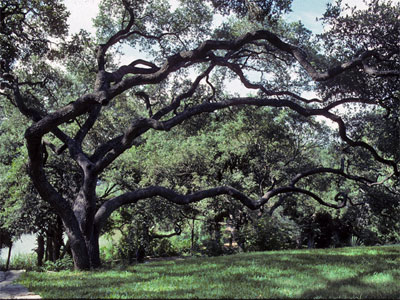
Live oak. All photos by Sally and Andy Wasowski.
Oaks of Texas
Home to a whopping 74 percent of all oak species in the U.S., Texas has the greatest number of oaks in the nation, harboring around 43 species and two varieties. Of these, a few are shrubs, but most are trees. Oaks are divided into two groups, white oaks and black or red oaks.
White oaks produce acorns every year, insides of acorn cups are smooth, leaves lack bristle tips, and bark is generally white and scaly. (Bur oak, chinquapin oak, coast live oak, escarpment live oak, lacey oak, post oak.)
Black or red oaks produce acorns that typically take two years to mature, acorn cups are fuzzy, leaves are bristle-tipped, and bark is rutted and dark. (Texas red oak.)
Deeper, richer, and moister soils generally produce taller trees with lush foliage. All of the trees discussed below prefer good drainage and take part shade to full sun. Acorns provide important food sources for wildlife, including wild turkey, javelina, and white-tailed deer. Early people consumed acorns leached of tannic acid and ground into flour.
Oak wilt is a serious and potentially fatal fungal disease that is present throughout the state. The black or red oak group is the more susceptible, while the white oak group is more resistant. Because roots of live oaks intermingle and thus transfer the disease from one individual to another, they are moderately vulnerable. When trimming any oak species, it is advisable to prune at the right times of year and to treat all cuts with pruning sealer. (See oak wilt link in the bibliography below.)
Many oaks make majestic shade trees, but you may need patience as they have a reputation for not growing as quickly as some other species. Plant them as a gift to future generations. You may be tempted to plant larger specimens to compensate for moderate growth; however, trees from smaller containers catch up to larger ones within just a few years. Like kids whose wounds heal faster, smaller trees are more tenacious and establish more rapidly. They also will need supplemental water for a shorter amount of time.
Fall or winter, when plants are dormant, is the best time to plant native trees. Here are a few good oaks for Texas landscapes:
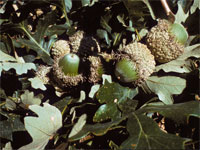
Bur oak.
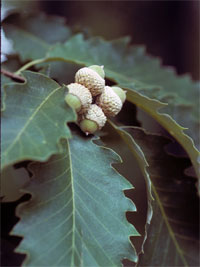
Chinquapin oak.
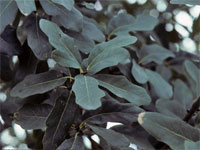
Lacey oak.
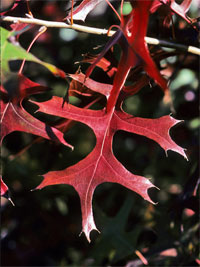
Texas red oak.
Bur oak (Quercus macrocarpa)
60 to 75 feet tall, 30- to 50-foot spread. Bur oak occurs in the eastern half of Texas. The name “macrocarpa” literally means “large seed,” referring to the acorns that can reach nearly 2 inches in diameter. Keep this in mind as you select a site; the acorns are large enough to pock mark a car or cause inattentive pedestrians to stumble. In the right place, this is a magnificent tree with large, deeply lobed leaves that are easy to rake. Bur oak is faster growing than other oaks.
Chinquapin oak (Quercus muhlenbergii)
40 to 60 ft. tall, 20- to 40-foot spread. Also relatively fast growing, Chinquapin oak is found on calcareous soils from the Trans-Pecos to Central and North Central Texas. Its leaves are dark and glossy with coarsely toothed edges. The name “chinquapin” was selected due to the variety’s resemblance to the Allegheny chinquapin (not an oak).
Escarpment live oak (Quercus fusiformis)
30 to 40 feet tall, 30- to 50-foot spread. Dubbed “live oaks” because they hold their leaves through winter, the trees usually defoliate around March-April and are not technically “evergreen.” Suckers sprout from the roots, often creating mottes. Escarpment live oaks hybridize with coast live oaks, so we get a gradation of the two as we move from west to east. Therefore, it is important to plant specimens from a local source.
Coast live oak (Quercus viriniana)
40 to 60 feet tall, 50- to 80-foot spread. Less cold-hardy and drought-tolerant than escarpment live oak, coast live oak is otherwise very similar to escarpment live oak.
Lacey oak (Quercus laceyi)
20 to 40 feet tall, 20- to 30-foot spread. This attractive denizen of the Edwards Plateau grows on well-drained, often thin, limestone soils and is exceptionally drought-tolerant. Soft gray-green leaves of summer are pinkish-orange when they emerge in spring and have a similar peach-ish color in fall.
Post oak (Quercus stellata)
40 to 70 feet tall, 30- to 40-foot spread. Throughout the eastern two-thirds of the state, dry sandy woodlands with neutral to acidic pH soils are where post oaks thrive. Their root zones are particularly sensitive to disturbances such as compaction, paving over, burying, and overwatering. Branches on mature trees are stout, twisty, and often gnarled, giving the trees exceptional character. Post oaks are difficult to transplant, and they are seldom seen in Texas nurseries.
Texas red oak/Spanish oak (Quercus texana, Quercus buckleyi)
30 to 50 feet tall, 20- to 40-foot spread. Found on limestone soils of the Edwards Plateau and gravels of the Cross Timbers, Texas red oak has one of the best shows of color in fall, turning a dark scarlet around Thanksgiving and hanging on to dried leaves longer than most deciduous trees. It hybridizes naturally with Shumard oak, so it is best to select trees from a local source.
Shumard red oak (Quercus shumardii)
90 to 120 feet tall, 50-foot spread. Closely related to the Texas red oak and often hybridizing with it, the Shumard red oak also shows brilliant burgundy fall color and hold its leaves into December. Its natural range is the eastern third of Texas, but it does well throughout the state. Shumards are relatively fast growing under ideal conditions and are an excellent shade tree for landscapes.
For more information about Texas native plants, visit the Wildflower Center’s website at: www.wildflower.org.
About the author: Andrea DeLong-Amaya is the director of horticulture at the Lady Bird Johnson Wildflower Center in Austin.
Bibliography
Simpson, Benny J. 1988. A Field Guide to Texas Trees. Houston: Gulf
Publishing Company.
Tull, Delena. 1987. A Practical Guide to Edible and Useful Plants. Austin: Texas
Monthly Press, Inc.
Vines, Robert A. 1984. Trees of Central Texas. Austin: University of Texas Press.
Wasowski, Sally and Andy Wasowski. 1988. Native Texas Plants
Landscaping Region by Region. Houston: Gulf Publishing Company.
www.texasoakwilt.org
